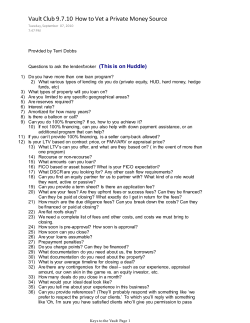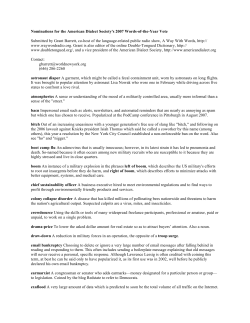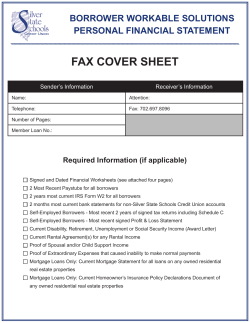
FHA Manual Underwriting
April 8, 2014 PACUWL-2014-029 Content: Reserve Requirements, Credit Score Requirements, Qualifying Ratios, Residual Income Effective for case numbers assigned on or after April 21, 2014 FHA Manual Underwriting HUD ML 2014-02 provides definitive requirements for manually underwritten transactions. Manual underwriting is required on the following: Purchase and credit qualifying refinance transactions that receive a TOTAL Scorecard Refer recommendation. Loans that could not be scored due to non-traditional credit or insufficient credit. Loans in which the borrower does not have a credit score. TOTAL Scorecard Accept recommendations that must be manually downgraded. Loan decision scores <620 when the borrower’s DTI is >43%. Pacific Union Financial, LLC (Pacific Union) will follow the guidance provide by HUD in ML 2014-02 for loans with case numbers assigned on or after April 21, 2014. As a result of HUD’s definitive DTI requirements, Pacific Union Financial is lifting its DTI overlays for manually underwritten loans. The following is a brief summary of the pending changes. Reserve Requirements All manually underwritten purchase and credit qualifying refinance transactions must meet the following minimum reserve requirements: 1-2 unit properties – 1 month PITI 3-4 unit properties – 3 months PITI Pacific Union overlays for New Jersey 2-4 unit properties will continue to apply. Note: The previous 2 month reserves requirement for borrowers with insufficient credit and purchasing a 12 unit property is no longer applicable. Funds available for required reserves MAY NOT include the following: The amount of cash taken at settlement in cash-out transactions; or Incidental cash received during the settlement of another loan transactions; or Gift funds in excess of the amount required for the down payment and other expenses; or Equity in another property; or Borrowed funds from any source. Page 1 of 6 Credit Score Requirements The median (middle) credit score value is used as the decision credit score. When only two credit scores are available, the lower of the two is chosen; when only one is available, that score is used. When the loan includes multiple borrowers, the minimum decision score must be determined for each borrower as described above, and then the lowest decision score is selected as the minimum loan decision score. If one borrower does not have a credit score (non-traditional or insufficient credit), the lowest credit score of the borrower(s) must be used as the minimum loan decision score. Note: The term “Loan Score” has been changed to “Loan Decision Score” throughout the FHA Program Guide. Qualifying Ratios The standard DTI ratios for FHA manually underwritten transactions are 31% / 43%. Either or both of these ratios may be exceeded with verified and documented compensating factors. HUD ML 2014-02 establishes the maximum front-end and back-end ratios based on the minimum loan decision score and acceptable compensating factors as shown in the table below. Note: The DTI Ratio Matrix provides a brief description of allowable compensating factors. Refer to the Compensating Factors table for additional information. Maximum Debt-To-Income (DTI) Ratio Matrix Manually Underwritten Transactions (Refer/Eligible, Manually Downgraded Loans or Credit Qualifying Streamlines) Effective For Case Numbers Assigned On or After April 21, 2014 Lowest Minimum Loan Maximum Acceptable Compensating Factors Decision Score DTI ≥580 40% / 50% Two of the following compensating factors are required: Verified and documented cash reserves; or Minimal increase in housing payment; or Significant additional income not reflected in the gross effective income; or Residual income ≥580 40% / 40% The borrower must meet all the following requirements: Monthly housing payment must be the only open installment account and must have a minimum 6 month payment history; and Revolving credit must have been paid in full each month during the most recent 6 month period. ≥580 37% / 47% Note: Other debts and additional compensating factors are not allowed. One of the following compensating factors is required: Page 2 of 6 ≥580 560-579 or NonTraditional/Insufficient Credit 31% / 43% 31% / 43% Verified and documented cash reserves; or Minimal increase in housing payment; or Residual income Compensating factors are not required. The DTI may not be exceeded regardless of compensating factors. Non-traditional credit: Income from nonoccupant co-borrowers may be included in the DTI ratios. Insufficient credit: Only income from borrowers occupying the property and obligated on the loan may be used. Notes: Second level underwriting review may be required for loans that exceed 33% / 45% ratios. DTI requirements do not apply to non-credit qualifying Streamline refinance transactions. Compensating Factors As a reminder, all compensating factors must be: Clearly identified on the 92900-LTR; and Comply with HUD’s requirements. ML 2014-02 provides very specific guidance as to the types of compensating factors that are permitted for various scenarios. Acceptable Compensating Factor Minimal increase in housing payment Requirements To Support The Compensating Factor The new total monthly mortgage payment does not exceed the current total monthly housing payment by more than $100 or 5%, whichever is less; and For purchase, streamline and rate/term refinances: the previous housing payment history must include no more than one mortgage late payment within the most recent twelve months; or For cash-out transactions: all mortgage payments must have been paid within the month due within the most recent twelve months. Note: If the borrower does not have a current housing payment, minimal increase in housing payment cannot be used as a compensating factor. Discretionary debt May be considered a compensating factor when all of the following apply: The borrower’s housing payment is the only open account with an outstanding balance that is not paid off monthly; The credit report shows established credit (revolving and/or installment) in the borrower’s name open for at least six months and it is verified that the credit account has been Page 3 of 6 paid in full monthly within the most recent six month period. Residual income Significant additional income not reflected in gross effective income Must be equal to or higher than the applicable amounts on the Table of Residual Income by Region and calculated based on the following: All members of the household income may be included in the calculation, regardless of the nature of their relationship and without regard to whether they will be on the Note or title to the property. Members of the household may be omitted from the “family size” when determining residual income as a compensating factor, if the family member provides sufficient documentation verifying that they are fully supported by a source of income not included in the loan analysis. Verified and documented significant overtime or bonus income that is not considered effective income, but the borrower has received the income for at least one year but less than two years. The income must be likely to continue. Verified and document part-time or seasonal employment with income that is not considered effective income, but the borrower’s part-time and seasonal work status has been uninterrupted for at least one year but less than two years and there are plans to continue this work. Note: If the income were included in the gross effective income, it must have been sufficient enough to reduce the qualifying ratios to ≤ 37% / 47%. Income from non-borrowing spouses or other parties not obligated on the mortgage may not be included. Verified and documented cash reserves The borrower has substantial documented cash reserves. This is defined as three months PITI for 1-2 unit properties and six months PITI for 3-4 unit properties. The reserves must be liquid or readily convertible to cash, and can be done so absent retirement or job termination. Funds and/or assets that are not to be considered as cash reserves include: Gift funds; Equity in other properties; Proceeds from a cash-out refinance; Borrowed funds; Incidental cash received at closing in the loan transaction. A portion of a borrower's retirement account (IRA, Thrift Savings Plan, 401k, and Keogh accounts) may be considered, subject to the following conditions: To account for withdrawal penalties and taxes, only 60% of Page 4 of 6 the vested amount of the account, less any outstanding loans, may be used. Requires documentation of the existence of the account with the most recent depository or brokerage account statement. In addition, evidence must be provided that the retirement account allows for withdrawals under conditions other than in connection with the borrower's employment termination, retirement, or death. If withdrawals can only be made in connection with the borrower’s employment termination, retirement, or death, the retirement account may not be included as cash reserves. If any of these funds are also to be used for loan settlement, that amount must be subtracted from the amount included as cash reserves. Note: The compensating factors must be noted on the 92900-LT and, if applicable, a worksheet must be attached to reflect the calculation of residual income. Residual Income HUD’s compensating factors now include residual income, defined as the amount of income remaining after deductions. HUD has modeled their residual income calculation to mirror VA requirements and is utilizing the VA Table of Residual Incomes by Region to determine if residual income is sufficient to qualify as a compensating factor. The following guidelines apply when determining the total/gross income to be used for this calculation: May not include bonus, part-time or seasonal income that does not meet HUD’s effective income requirements. Income from non-occupying co-borrower, co-signers, non-borrower spouses, or other parties not obligated on the mortgage may not be included. Non-taxable income may not be “grossed up”, taxes are taken into account during the residual income calculations. After determining the total/gross income, the following deductions are applied to determine the Residual Income: The proposed total monthly fixed payment. State, Federal, local or other income taxes. If available, use the borrower’s most recent tax returns to document federal, state and local taxes liabilities or taxes can be calculated using the most recent IRS Tax Tables and state or local taxing authorities tax requirements. Retirement and Social Security. Paystubs or tax returns may be used to determine the maximum deduction. Estimated maintenance and utility cost. This deduction may be estimated by multiplying the living area of the property (square feet) by 14 cents. Job related expenses (e.g. child care) FHA requires a specific amount of monthly residual income be available for the borrower’s use after closing. This amount is based on the family size, location of the property and loan amount as shown in the table below. Page 5 of 6 Table for Residual Income By Region: Family Size 1 2 3 4 5 Over 5 1 2 3 4 5 Over 5 Region Northeast Midwest South West Loan Amounts $79,999 and Below Northeast Midwest South $39 $38 $38 0 $65 2 2 $64 $64 4 1 1 $78 $77 $77 West $42 5 $71 3 $85 8 2 2 9 $88 $86 $86 $96 $92 8 8 8 7 $90 $90 $1,004 1 Add $75 for each 2 additional family 2 member up to 7 Loan Amounts $80,000 and Above $45 $44 $44 $49 0 $75 1 1 1 $73 $73 $82 5 $90 8 8 3 $88 $88 $99 9 $102 9 9 0 $1003 $1003 $1117 5 $106 $1039 $1039 $1158 2 Add $80 for each additional family member up to 7 States CT, MA, ME, NH, NJ, NY, PA, RI, VT IA, IL, IN, KS, MI, MN, MO, ND, NE, OH, SD, WI AL, AR, DC, DE, FL, GA, KY, LA, MD, MS, NC, OK, PR, SC, TN, TX, VA, VI, WV AK, AZ, CA, CO, HI, ID, MT, NM, NV, OR, UT, WA, WY The FHA Program Guide and supporting documentation will be updated to reflect these changes on April 14, 2014. Please contact your Account Executive with any questions. Thank you for your business. April 8, 2014 PACUWL-2014-029 © 2014, Pacific Union Financial, LLC. All Rights Reserved. This document is limited to current Pacific Union Financial policy and practice and should not be construed as legal advice, legal opinion, or any other advice on specific facts or circumstances. Such policy and practice is subject to change. The recipient should contact its legal counsel for legal advice. For business and professional use only. Not for consumer distribution. All loans subject to approval. Certain conditions and fees apply. Pacific Union Financial, LLC. Equal Housing Opportunity Page 6 of 6
© Copyright 2025











